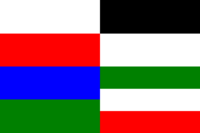Prusi

| |
| Subdivision of: | Veneda (Republic of the Two Crowns) |
| Languages: | |
| Official: | Venedic |
| Others: | Prussian, German, Saxon, Lithuanian |
| Cities: | |
| Capital: | Męć Rzegały |
| Other: | Olesztyn, Elbiądz |
| Population: | 2,905,853 Prussians |
| Time zone: | UTC +1 |
| Code: | <1 (or V1) |
Prussia (Prusi, Prūsa, Preußen, Prüyssen) is a province of Veneda, Republic of the Two Crowns.
Geography
The province of Prusi is located in the Northeast of Veneda. It borders with Danzig and the province of Przemarz (to the West), the provinces Kujawia, Mazowia and Suślewia (to the South), Wilnia and Samogitia (to the East), as well as with the Baltic Sea (to the North). The province's main river is the Przegola.
History
Before the Second Great War this territory was part of the Holy Roman Empire. The population of the area was always mixed however, with Lithuanians making the majority of inhabitants in the Northeast, Masurians (similar to Veneds) in the South, Baltic Prussians in the West and German/Saxon speaking people in the center and in the main cities. The first Germans and Saxons arrived to the area with the Teutonic Order in order to Christianise Lithuanians and Prussians in the medieval period. However, the process of Germanisation was especially strong in the area in the 18th-20th centuries, and therefore many German and Saxon speaking people were in fact germanised ethnic Prussians, Lithuanians or Masurians.
The Treaty of Visby of 1949 ceded East Prussia to the Republic of the Two Crowns and most of it became Prussia province of Veneda. Initially the issue of Prussia created some discontent between Veneda and Lithuania as Lithuania seeked to acquire Lithuania Minor, which the snorist Lithuanian State controlled in 1947-1949. However, the majority of the Lithuanian government at the time supported the union with Veneda.
The snorist occupational government deported many Germans westwards during the Second Great War according to the Act of Return. After 1949 large numbers of Germans and Saxons emigrated on their own will. The Venedic government attempted to challenge former domination of the German language and culture in the area by trying to support the cultural plurality of four cultures (German/Saxon, Baltic Prussian, Venedic, Lithuanian). Under this policy many schools with Venedic, Lithuanian and Prussian languages as medium of instruction were opened in the 50s. The Venedic language was to replace German as lingua franca of this multicultural place. As such it was (and still is) taught in all schools whereas German lessons were made optional. Venedic gradually became the language to be used in courts, for dubbing/subtitling foreign films in cinemas and so on. This caused friction between Republic of the Two Crowns and the Holy Roman Empire, which regarded this to be a policy of Venedisation.
This policy met opposition not only from local Germans and Saxons but from some Lithuanians, Masurians and Prussians as well. Some of these people were more happy with the pre-war situation, and they believed that German language is more important to them than Venedic (sometimes also that German culture is superior to that of Veneda or Lithuania). The large damages suffered by the area during the war elevated the discontent. In the 1951 census of the Republic of the Two Crowns it was common to name one's ethnicity to be Lietuvinink or Masurian rather than Lithuanian or Vened.
Immigration from other parts of the Republic of the Two Crowns further increased the population of Veneds and to a lesser extent Lithuanians as well as created new minorities of Ukrainians and Belarussians.
Politics
Prussia is governed by a governor and a provincial diet, elected each four years in provincial and municipal elections that encompass all Veneda. It consists of 96 members. The composition of the Prussian Diet, elected in 2003, is as follows:
| Party | Seats |
|---|---|
| WWPS – Venedic Unified Socialist Party | 12 |
| UD-DS – Democratic Union | 11 |
| BR – Republican Bloc | 10 |
| DSEP – German-Saxon Unity Party | 9 |
| PPPP – People’s Party of the Province of Prussia | 7 |
| MDLP – Democratic Movement of Lietuvinink in Prussia | 5 |
| SPB – Society of Baltic Prussians | 5 |
| UChN – Christian-National Union | 4 |
| LiD – Freedom and Democracy | 4 |
| DN – National Democracy | 4 |
| OLD – Alliance of the Democratic Left | 4 |
| SVP – Saxon People’s Party | 4 |
| SJW – Self-defense of Venedic Peasants | 3 |
| WPP – Venedic People’s Party | 3 |
| UŁ – Labour Union | 2 |
| PKRDK – Communist Party of the RTC | 2 |
| BNSP – Neutral Bloc for the Support of Progress | 2 |
| OC – Central Alliance | 2 |
| PChD – Christian-Democratic Party | 1 |
| KRN – Confederation for an Independent Republic | 1 |
| Wierdzi – Greens | 1 |
For an explanation of the parties, see: Political parties in the RTC
Demography
- Veneds - 27.3%
- Prussians - 21.5% (until 1960 officially reffered to as Baltic Prussians)
- Germans - 19.8%
- Saxons - 15.8%
- Lithuanians - 10.2%
- Others - 5.4%
| |||
|---|---|---|---|
| Countries | |||
| Lithuania | Veneda Galicia (autonomous area) | Venedic West Africa (overseas territory) | |||
| Provinces | |||
| Great Veneda | Hałycz | Karpatia | Kujawia | Leonina | Lesser Veneda | Liublin | Mazowia | Olwarzyn | Polesia | Prussia | Przemarz | Samogitia | Sątakrucz | Silesia | Suślewia | Volhynia | Wilnia |
This page was created by Abdul-aziz. |